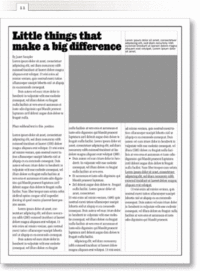

Use our online designer studio to create your own personalised flyers, business cards, greeting cards and more.
Order NowWhen it comes to professional printing and advice on your business marketing, we are the team to call! You can call us direct on 04 568 8773 or fill in our quote form.
Request a Quote
From business cards to address labels, there are countless small printed items that businesses use every day. The challenge is getting those items to be clear when you don’t have room to spread things out as you would on an A4 page. I’ve done a lot of interesting things that have to printed on very small spaces over my time at Copy Express and here are my simple rules to making life easy when designing for a small space.
The first rule of any design is what is the role of the thing you are designing. What you have to do for a business card to work, is different to designing an effective shipping label. Spend your time thinking about how many ways it’s going to be used. If you have staff, talk to them about what you are designing as they will have ideas of what will work for them. All too often people get caught up in the process of design spending time on making it look cool, then have to go through the process again after throwing out the first version because it doesn’t do its job.
The worst thing you can do when designing for a small space item, like a business card, is to try and cram everything in on one side. Cramped up text is hard to follow and confusing to read. It is better to leave less important details out, or put them on the other side of the document if you have them. While turning an item from one sided to two sided will add to your production costs, the increase in price is relatively small and the improvement of the look will make you more professional in your clients eyes.
The simple rule is that body fonts work best in small spaces. If you have several weights of fonts to choose from, standard size is better because very thick or thin fonts become unreadable below 9 point. Also if there is going to be a lot of text in small type then space the lines wider than normal (1.5+ line height instead of 1.1 or 1.2) as that improves readability.
The science and artistry of colour is far too great to be dealt with in a short blog item but here’s a handy rule of thumb, think about road signs and how they use colour. Road signs are designed to be as visually clear as possible from a great distance, so they use colours that have a high visibility when the sign is quite visually small. The same colour tricks apply to design in small spaces. Otherwise you can never beat black on a white background which has the best colour and contrast choice out there.
Don’t be afraid to play with direction of text. Less important information can be put at right angles or at the edges of a small space to maximize room for the important stuff. Try flowing text in to one line with break markers like ‘|’ or ‘•’ to mark each discrete part. Another way is to take the items and put them in to a narrow columns or bullet-point style lists. Unless you have to conform with an external standard, like the positioning of where a return address is printed, you can put text and graphics anywhere you like; as long as it makes logical sense then you will be fine.
This is the best thing I can recommend when you have to work with small space design. Design it, have a small batch of the item run off, use it, revise based on what did and did not work. Copy Express specialises in smaller volume runs, so we are ideally placed in doing this sort of work for you. We also have plenty of experience in small space design so we can help you through every step of the process to make sure you get exactly what you need.